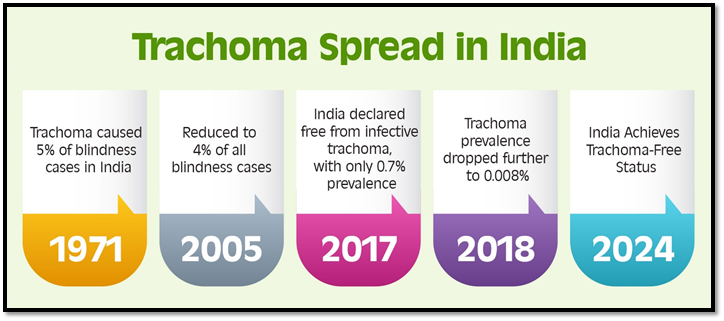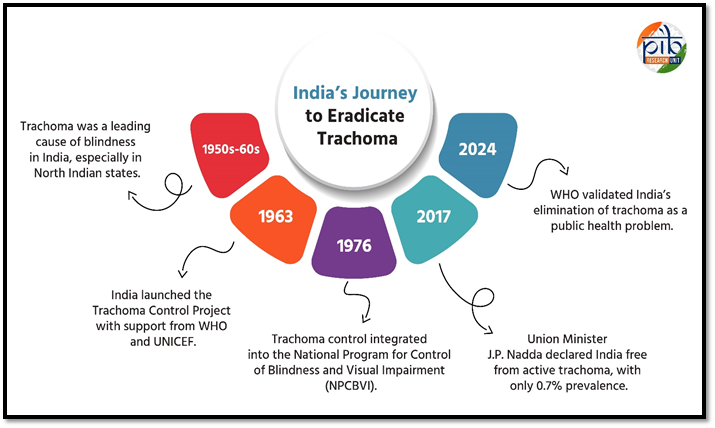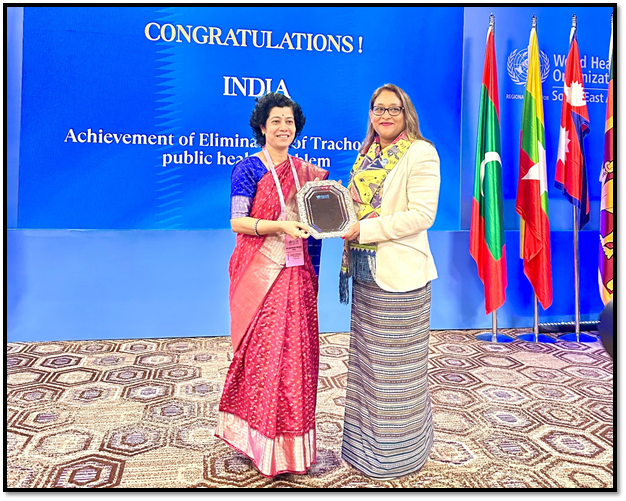Introduction
 Clear eyesight is one of life’s most precious gifts, essential for daily activities, education, and overall well-being. However, several diseases, such as trachoma, pose serious threats to eyesight, potentially leading to irreversible blindness if left untreated.
Clear eyesight is one of life’s most precious gifts, essential for daily activities, education, and overall well-being. However, several diseases, such as trachoma, pose serious threats to eyesight, potentially leading to irreversible blindness if left untreated.
Trachoma, a highly contagious bacterial infection, has been a major cause of preventable blindness worldwide.
According to WHO estimated 150 million people worldwide are affected by Trachoma and 6 million of them are blind or at risk of visually disabling complications. Among them the infective stages of trachoma are usually found in children.
In a significant public health achievement, India has been officially declared free from trachoma by the World Health Organization (WHO). This milestone comes after years of dedicated efforts by the government to protect the vision of millions, emphasizing the importance of healthy eyesight for every individual.
What is Trachoma?
Trachoma is a devastating eye disease caused by infection with the bacterium Chlamydia trachomatis. The primary source of trachoma infection is the eye secretions of infected individuals, it can be transmitted through several routes, including:
- Close physical contact, such as playing together or sharing a bed, especially among mothers and affected children.
- Sharing towels, handkerchiefs, pillows, and other personal items.
- Houseflies, which can carry the infection.
- Coughing and sneezing.
Environmental risk factors that promote the transmission of trachoma include:
- Poor hygiene practices.
- Overcrowded living conditions.
- Water scarcity.
- Inadequate latrines and sanitation facilities.
Addressing these risk factors is crucial to breaking the cycle of transmission and preventing the further spread of the disease.
Children are more vulnerable to trachoma:
As children experience repeated infections, scarring can occur on the inner surface of their upper eyelids. This scarring leads to a painful condition known as trachomatous trichiasis, where the eyelid margin turns inward, causing the eyelashes to constantly rub against the eyeball, but the hazards don’t end there. If left untreated, this condition can lead to visual impairment. Research shows that individuals may need to endure more than 150 infections over their lifetime to develop severe complications associated with blinding trachoma.
India’s Victory Against Trachoma
During the 1950s and 1960s trachoma was a significant public health concern in India. States like Gujarat, Rajasthan, Punjab, Haryana, Uttar Pradesh, and the Nicobar Islands were heavily impacted, with over 50% of their populations affected during that period. By 1971, trachoma was responsible for 5% of all blindness cases in the country. In response to this pressing issue, India implemented a series of measures aimed at eradicating the problem.

Initiatives to Combat Trachoma
Recognizing the urgent need to combat the trachoma health crisis, India implemented several key interventions under the National Programme for Control of Blindness and Visual Impairment (NPCBVI). A pivotal moment in this effort was the adoption of the WHO SAFE strategy, which aimed not only to treat existing cases but also to prevent future infections through improved hygiene practices. Have a look to the various steps taken by India over the time to combat trachoma:
- Launch of the National Trachoma Control Program: In 1963, the Government of India, with support from WHO and UNICEF, launched the National Trachoma Control Program. This initiative laid the groundwork for comprehensive trachoma management, focusing on:
- Surgical Treatment: Addressing the blinding stage of the disease, known as trachomatous trichiasis
- Antibiotic Distribution: Clearing existing infections
- Facial Cleanliness: Promoting hygiene to reduce transmission
- Environmental Improvements: Enhancing access to water and sanitation.
- Integration into National Programs: In 1976, trachoma control efforts were integrated into the broader NPCBVI framework, ensuring sustained focus and resources for elimination activities.
- Significant Progress: In 2005, trachoma accounted for 4% of all blindness cases in India. Remarkably, by 2018, this figure declined to just 0.008%. The success of these efforts was validated through a series of impact assessments, pre-validation, and trichiasis-only surveys, confirming that elimination targets were met in all previously endemic regions.

Through these continuous efforts, India has made significant strides toward eradicating trachoma. By 2017, India was declared free from infective trachoma. This announcement came during the release of the National Trachoma Survey Report (2014-17) by the then Union Minister of Health and Family Welfare, J.P. Nadda. The survey findings were promising, indicating that active trachoma infections had been eliminated among children in all surveyed districts, with an overall prevalence of only 0.7%—well below the World Health Organization’s (WHO) elimination threshold of 5%.
Despite this remarkable progress, the commitment to public health did not end there. From 2019 to 2024, India continued its vigilant surveillance for trachoma cases across all districts to ensure that the infection did not re-emerge. This ongoing monitoring is crucial for maintaining the hard-won status of being trachoma-free, demonstrating India’s dedication to safeguarding the eye health of its citizens and preventing avoidable blindness.
WHO Applauds India’s Effective Measures Against Trachoma
WHO Director-General Dr. Tedros Adhanom Ghebreyesus praised India’s commitment to alleviating the suffering caused by trachoma, emphasizing the vital collaboration among the government, healthcare professionals, and international partners that made this milestone possible.
India now stands alongside Nepal, Myanmar, and 19 other countries that have also successfully eliminated trachoma as a public health issue. However, the disease continues to be a challenge in 39 other nations, affecting approximately 1.9 million people globally and leading to irreversible blindness in many cases.

Conclusion
India’s journey to becoming trachoma-free showcases the strength of teamwork in public health and community support. By adopting the WHO SAFE strategy the country has successfully lowered the rates of this serious eye disease. The cooperation among government bodies, healthcare workers, and international partners has been key to this success. As India joins other nations that have eradicated trachoma as a public health issue, it highlights the need for ongoing efforts, consistent public health programs, and a dedication to ensuring that future generations can enjoy good eyesight.
 Matribhumi Samachar English
Matribhumi Samachar English


